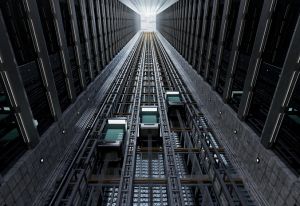
TYPES OF ELEVATORS
Believe it or not, elevators have been around since the 3rd century B.C! Elevators have come a long way since then.
There is no one size fits all elevator, though. Different places need different types of elevators.
We are going to guide you through understanding the different elevator types and help you to decide which is right for your building.
Let’s get moving!
THE MAIN TYPES OF ELEVATORS: WHICH IS RIGHT FOR YOUR BUILDING
There are several different types of elevators, and all of them might require different types of maintenance. Let’s take a look at which style is right for your needs.
GEARED AND GEARLESS TRACTION ELEVATORS
These elevators are generally not used in residential settings. They are geared more towards taller buildings. There are three main types of elevators in this style
The first type is the traction elevator. This elevator uses ropes and a wheel attached to an electric motor to move the car up and down.
Next is the geared traction elevator. The gears in this elevator power a wheel that moves the rope. The elevator can travel up to 500ft in one minute, but only a maximum distance of 250ft.
The final elevator in this series is the gearless traction elevator. This set up is perfect for skyscrapers and tall buildings. There is no gear to regulate speed so the car can travel up to 2,000ft per minute.
HYDRAULIC ELEVATORS
These elevators are easier to service and maintain than the action elevators. They are generally used in buildings between 2 and 8 stories. Like traction elevators, the hydraulic elevator has several different styles.
The roped hydraulic elevator uses both pistons and rope to move the car, however, it only travels a distance of 60ft.
The conventional hydraulic elevator also travels around 60ft but its set up is a little different. This elevator has a pit that holds the piston. As the elevator descends the piston goes down into the pit.
The final style is a hole-less hydraulic elevator. This elevator works the same way as the conventional except it does not have a pit. The travel is also limited with this style to around 20ft.
MACHINE-ROOM-LESS (MRL) ELEVATOR
This elevator can only travel 250ft with a speed of 500ft per minute. This makes it ideal for mid-size buildings. The nature of this elevator conserves energy and does not require as much space during its build.
VACUUM ELEVATOR
This elevator has only been around since 2005 but it has grown quickly in popularity. The elevator does not use any ropes or pulleys, but instead uses air to operate the car using physics.
The aluminum and polycarbonate car act as a tube inside of the shaft which is vacuum-sealed. The air above and below the car facilitates the movement.
This elevator is available in three styles: single passenger, three passengers, and handicapped-accessible. Because of its limited size, this style is generally only used in residential settings.
MOVING FORWARD
The different types of elevators are easy to choose from once you identify the size and needs of your building. Take time to adequately assess the building and then choose your style. Keep in mind that scheduled maintenance is always a necessity for your elevator safety.
If you would like to learn more about elevator services click here.